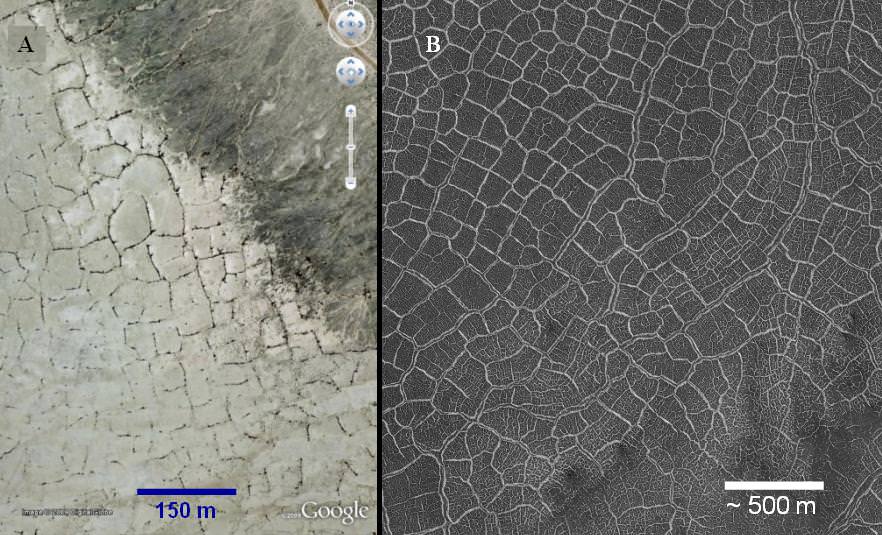[/caption]
Networks of giant polygonal troughs found in crater basins on Mars are cracks caused by evaporating lakes. These landforms had been attributed to thermal contractions in the Martian permafrost, similar to what the Phoenix lander explored near the north pole on the Red Planet. But these polygon-shaped cracks are too large to be caused by thermal contractions and provide further evidence of a warmer, wetter Martian past.
Speaking at the European Planetary Science Conference, M. Ramy El Maarry of the Max Planck Institute for Solar System Research said was excited when he saw that the crater floor polygons seemed to be too large to be caused by thermal processes. “I also saw that they resembled the desiccation cracks that we see on Earth in dried up lakes,” he said. “These are the same type of patterns you see when mud dries out in your back yard, but the stresses that build up when liquids evaporate can cause deep cracks and polygons on the scale I was seeing in the craters.”

The polygons are formed when long cracks in the surface of the Martian soil intersect. El Marry investigated networks of cracks inside 266 impact basins across the surface of Mars and observed polygons reaching up to 250 metres in diameter. Polygonal troughs have been imaged by several recent missions and until now, were thought to have been created by the same conditions as at the polar regions.
El Maarry created an analytical model to determine the depth and spacing of cracks caused by stresses building up through cooling in the Martian soil. He found that polygons caused by thermal contraction could have a maximum diameter of only about 65 meters, much smaller than the troughs he was seeing in the craters.
El Maarry identified the crater floor polygons using images taken by the MOC camera on Mars Global Surveyor and the HiRISE and Context cameras on Mars Reconnaissance Orbiter. The polygons in El Maarry’s survey had an average diameter of between 70 and 140 meters, with the width of the actual cracks ranging between 1 and 10 meters.
Evidence suggests that between 4.6 and 3.8 billion years ago, Mars was covered in significant amounts of water. Rain and river water would have collected inside impact crater basins, creating lakes that may have existed for several thousand years before drying out. However, El Maarry believes that, in the northern hemisphere, some of the crater floor polygons could have been formed much more recently.
“When a meteorite impacts with the martian surface, the heat can melt ice trapped beneath the martian crust and create what we call a hydrothermal system. Liquid water can fill the crater to form a lake, covered in a thick layer of ice. Even under current climatic conditions, this may take many thousands of years to disappear, finally resulting in the desiccation patterns,” said El Maarry.
Source: Europlanet


“The polygons in El Maarry’s survey had an average diameter of between 70 and 140 kilometers, with the width of the actual cracks ranging between 1 and 10 meters.” — Are the units correct? The photos are labeled meters, not kilometers.
On the picture with the 80 meter scale, on my monitor, one inch = 40 meters and the polygon was five inched, or 200 meters. The caption in the original article reads, — ”
Detailed image of large-scale crater floor polygons, caused by desiccation process, with smaller polygons caused by thermal contraction inside. The central polygon is 160 metres in diameter, smaller ones range 10 to 15 metres in width and the cracks are 5-10 metres across. Credit: NASA/JPL”
It is obviously meters; the press release contained an error.
Meters, kilometers, what’s a few orders of magnitude between friends? =P
I wonder how long before someone claims it’s the ruins of ancient cities.
Are you sure there not roads? Look close and you might see a flying disk.
Mars does have oceans, but they are frozen and subsurface now. What’s left of em anyway..? Periodic impact events release enough energy to create localized melting?
I wonder if like Earth, Mars has subsurface rivers?
I hope they also ruled out jointing caused by pressure unloading.
I assume the two different crack scales [for some reason, this topic cracks me up :-D] are a further test of having two different mechanisms?!
Anyway, a more consistent trace of “wet” mechanisms are both encouraging and making more sense. Mars, no longer a dry topic.